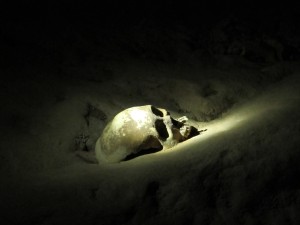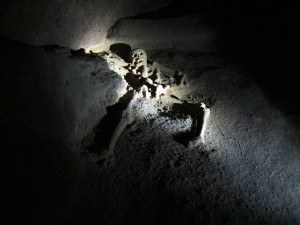If truth be know, I always prefer to describe myself as a traveller. It sounds so much more intrepid and exciting than that other T word. But let’s face – whatever my preference, I am still very much a tourist, and like every other tourist I happily trot off to see all of the tourist attractions. Red Square, Berlin Wall, Chichen Itza; tick, tick, tick. I’ve come to accept the crowds and the cameras, and enjoyed many a ubiquitous guided tour.
But every now and then, there’s a tourist attraction that surpasses expectations. It becomes more than just a guided tour, it becomes a memorable experience. That is what happened for me at the Actun Tunichil Muknal cave just outside of San Ignacio, Belize.
San Ignacio was not in our original travel plans, but we heard so much about this cave from other travellers that we decided a detour was in order. I’m so glad we did.
The ATM cave system was used heavily by the Mayans for many ceremonies and rituals; it’s chambers and ledges are littered with ancient ceramics and the remains of human sacrifices. To see them involved first a 40 minute hike through the Tapir Mountain Nature Reserve, to the cave mouth, and then another two hours swimming and scrambling through the caves. The scrambling, swimming and climbing was always going to win me over but what took this tour beyond merely another show-and-tell was our guide, Martin. Of Mayan descent, he spoke with such eloquence and pride about his ancestors that you couldn’t help but be moved by his words.
 At one point he had us turn off our headlamps and walk single file – one hand placed on the shoulder of the person in front – through the cave in the dark. I cannot stress how dark it was – you could not see your hand in front of your face. And then – as we waded through the waist-deep water in the black – Martin began to sing a Mayan prayer which echoed all around the chamber. It was truly beautiful moment.
At one point he had us turn off our headlamps and walk single file – one hand placed on the shoulder of the person in front – through the cave in the dark. I cannot stress how dark it was – you could not see your hand in front of your face. And then – as we waded through the waist-deep water in the black – Martin began to sing a Mayan prayer which echoed all around the chamber. It was truly beautiful moment.
Soon afterwards he took us to some rock formations which he – after leading tours through the cave for years and years – had learned to “play”. Tapping gently on different parts of the stalectities, he was able to create a rippling melody that left everyone amazed and delighted.
 When it came to explaining the significance of the relics, Martin again had all the knowledge. He told us the stories of Maya – how they lived, who they worshipped, what this cave meant to them. He told us the stories of the human sacrifices – including the Crystal Maiden – who willingly gave up their lives for their beliefs. What I loved about him was that he would give you the official explanation – devised by learned anthropologists – and then he would tell you what he thought. His interpretations often made as much sense – if not more – than all the academic theories.
When it came to explaining the significance of the relics, Martin again had all the knowledge. He told us the stories of Maya – how they lived, who they worshipped, what this cave meant to them. He told us the stories of the human sacrifices – including the Crystal Maiden – who willingly gave up their lives for their beliefs. What I loved about him was that he would give you the official explanation – devised by learned anthropologists – and then he would tell you what he thought. His interpretations often made as much sense – if not more – than all the academic theories.
The tour left us quite exhausted – four hours hiking, swimming and climbing will do that to you. But it also left us with the distinct knowledge that we had just visited a holy place, as holy as any church or mosque that you may care to step into. It was a cave and it was a tour, but at the end of the day it was also a very spiritual experience.

